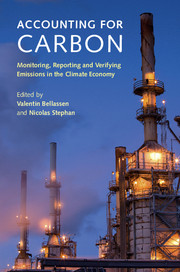Book contents
- Frontmatter
- Contents
- List of figures and map
- List of tables
- List of boxes
- Notes on contributors
- Acknowledgements
- 1 Introduction: key notions and trade-offs involved in MRVing emissions
- Part I MRV of territorial/jurisdictional emissions
- Part II MRV of industrial sites and entities
- Part III MRV at offset project scale
- Index
- References
1 - Introduction: key notions and trade-offs involved in MRVing emissions
Published online by Cambridge University Press: 05 March 2015
- Frontmatter
- Contents
- List of figures and map
- List of tables
- List of boxes
- Notes on contributors
- Acknowledgements
- 1 Introduction: key notions and trade-offs involved in MRVing emissions
- Part I MRV of territorial/jurisdictional emissions
- Part II MRV of industrial sites and entities
- Part III MRV at offset project scale
- Index
- References
Summary
Purpose and audience for this book
This book focuses on the monitoring, reporting and verification (MRV) of greenhouse gas emissions as it is practiced in the climate economy, that is in operational carbon pricing mechanisms as well as in the quantification of operational and territorial emissions for management purposes. It provides a description of the MRV procedures in place in the fifteen most important policy frameworks – national greenhouse gas inventories supervised by the United Nations, the European Emissions Trading System, the Australian carbon tax, the Clean Development Mechanism supervised by the United Nations, etc. – and compares them along key criteria such as scope, cost, uncertainty and flexibility. As such, this book does not consider other types of MRV than that of greenhouse gas emissions, such as the MRV of climate finance or the monitoring of the efficiency of climate policies, although they also have their place in climate economics.
This book leans heavily towards the practical problems and solutions employed by those involved in the MRV of existing frameworks. In other words, it describes how MRV is currently practiced by economic agents much more than how greenhouse gas emissions could or should be monitored, reported and verified based on the most recent developments in climate sciences or the deepest rooted economics theory. As such, this book does not consider the MRV of future frameworks for which there is no set of identifiable rules and practices such as the elusive and multiform Nationally Appropriate Mitigation Actions (NAMAs) for which plans are being communicated by various countries to the United Nations.
The audience for this book are those who wish to understand the key stakes attached to monitoring, reporting and verifying emissions, and the choices made by up-and-running carbon pricing initiatives regarding these stakes. This book is written by engineers and economists active in this field, but for a general audience who may not be proficient in climate economics or MRV procedures.
- Type
- Chapter
- Information
- Accounting for CarbonMonitoring, Reporting and Verifying Emissions in the Climate Economy, pp. 1 - 18Publisher: Cambridge University PressPrint publication year: 2015
References
- 2
- Cited by



